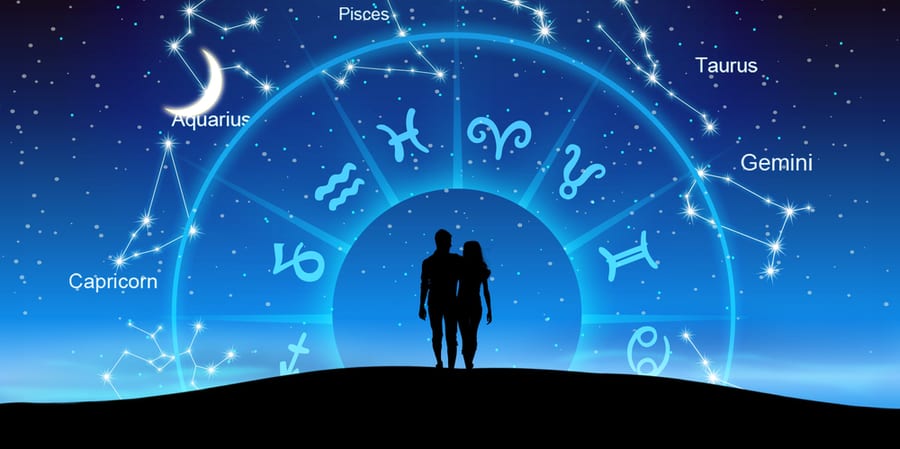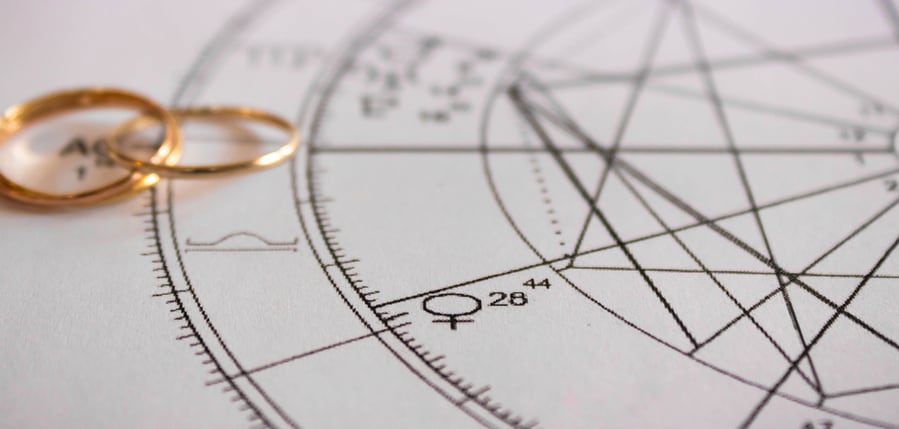
So you’ve got a synastry chart. Now what?
First of all, let’s clear up what a synastry chart is: it’s simply a map of how two people are connected.
This means that when we talk about “your chart,” we’re talking about the relationship between you and… whoever! Your best friend? Your mom? The person you’ve been dating for three months?
It doesn’t matter who—as long as they’re in your life and you want to understand them better.
Reading a synastry chart starts with understanding the planets, signs, and houses of the two individuals and of how they interact with one another. A planet represents the parts of our personalities. The signs are how these parts are expressed. Finally, the houses are the areas of our lives the planets and their expression focus on.
Interpreting a synastry chart can be tricky because there are so many factors at play! To make sense of it all, let’s discuss the most basic components and steps in reading a synastry chart.
What Is a Synastry Chart?

Synastry is a lot like astrology’s version of a compatibility test. It’s the art of comparing two charts to get a better sense of how two people interact with each other, and it can be really helpful when you’re trying to understand another person in the context of their relationship with you.
You can generate a synastry chart for any relationship: lovers, child and parent, friends, co-workers. It is not necessarily romantic, though that is commonly the way it is interpreted.
If you want to see how your astrological compatibility compares with another person, you can use a synastry chart to do so.
In a nutshell, these are the components of a synastry chart or any astrological chart for that matter:
Planets: WHAT is happening (e.g., Mercury rules communication)
Sign: HOW the energy is being expressed (Aquarius is honest and eccentric)
Houses: WHERE it’s happening (e.g., The 9th House rules higher education and travel)
Aspects: The ANGLE planets make with one another (Neptune sextile Pluto)
Orbs: The MARGIN of difference from an exact aspect (Neptune sextile Pluto with an orb of 3°02′)
How Do I Get A Synastry Chart?
First, you’ll need the birthday, birthplace, and birth time of two people.
Go to Astro Seek to input the birth details. I like Astro Seek’s Synastry Chart generator because of how detailed it is. It’s clear and has extra tables for reference, which is perfect for beginners!
It’s okay if you don’t know the birth time, you can just tick the ‘unknown time’ box.
Basics of Reading The Synastry Chart
For this article, we will be looking at Angelina Jolie and Brad Pitt’s synastry chart. The website allows you to download a copy of the synastry chart and aspect tables.

Table 1 displays each individual’s birth chart placements. Table 2 makes our lives easier by showing us the House overlays of the synastry chart.
To make it even easier to visualize, I’ve shaded Brad’s houses in yellow, and Angelina’s in pink.
The outermost circle is the zodiac wheel. They have the signs in order from Aries to Pisces. The second outermost are Brad’s numbered houses and planets (in red). The pink wheel are Angelina’s houses, whose planets are in blue.
As you can see, a synastry chart is a side-by-side comparison of the birth charts of two people. With the circular form, you can easily see how their houses match up with one another and where each of their planets falls in the other’s houses.
Even if both people have strong, well-formed natal charts, there are still ways that they can clash—and these clashes can be major obstacles to their relationship.
Aspects
The five major aspects in every astrological chart are the conjunction, trine, sextile, square, and opposition. To make it easier, I’ve made an angles table with the 5 major angles or aspects for each sign.
Conjunction
The planets are usually in the same sign and express the energy of their respective planets in the same way. This works well if the planets are harmonious with one another (such as Venus and Jupiter) but tricky when they’re discordant (like the Moon and Mars).
Trine
The planets are four signs apart and share the same element. Arguably the most benefic angle, the two planets get along and share similar temperaments and goals.
Sextile
This is a fun, light-hearted aspect. With the exception of their opposing signs, air signs sextile fire signs, and earth signs sextile the water signs.
Square
The planets share the same modality but with the exception of the opposite sign. The signs involved are traditionally the least compatible. This is a hard aspect, it causes plenty of friction and a lot of work to hurdle through your differences.
In Brangelina’s synastry chart, you can see that both of their Mars almost square each other exactly. The term square is literal: since the signs are 90° apart, they form a square when lines are drawn from the center to the two signs.
Opposition
The signs are opposite of one another in a chart. A challenging aspect in natal, but I personally like oppositions in synastry charts. It creates enough difference for intrigue and tension but also opportunities to develop a relationship.
| Sign | Trine | Sextile | Square | Opposition |
|---|---|---|---|---|
| Aries | Leo, Sagittarius | Gemini, Aquarius | Cancer, Capricorn | Libra |
| Taurus | Virgo, Capricorn | Cancer, Pisces | Leo, Aquarius | Scorpio |
| Gemini | Libra, Aquarius | Aries, Leo | Virgo, Pisces | Sagittarius |
| Cancer | Scorpio, Pisces | Virgo, Capricorn | Libra, Aries | Capricorn |
| Leo | Aries, Sagittarius | Gemini, Libra | Taurus, Scorpio | Aquarius |
| Virgo | Taurus, Capricorn | Cancer, Scorpio | Gemini, Sagittarius | Pisces |
| Libra | Gemini, Aquarius | Leo, Sagittarius | Cancer, Capricorn | Aries |
| Scorpio | Cancer, Pisces | Virgo, Capricorn | Leo, Aquarius | Taurus |
| Sagittarius | Leo, Aries | Libra, Aquarius | Virgo, Pisces | Gemini |
| Capricorn | Virgo, Taurus | Scorpio, Pisces | Libra, Aries | Cancer |
| Aquarius | Libra, Gemini | Sagittarius, Aries | Scorpio, Taurus | Leo |
| Pisces | Scorpio, Cancer | Capricorn, Taurus | Sagittarius, Gemini | Virgo |
Orbs
Orbs denote how exact an aspect is or how close it is to a perfect angle. Going back to Brangelina’s chart, Angelina’s rising or Ascendant is opposite Brad’s Venus (pictured below) because they are 185° apart.

We then would say that the connection is an Ascendant opposite Venus with an orb or margin of influence of 5°25′.
Reading The Synastry Chart

Now that we’ve got those basics down, let’s take a look at how this works in practice!
The aspects between planets are the most important component of a synastry chart. The great thing about Astro Seek is that it provides descriptions for all the major aspects of your synastry chart.
Planets and Aspects
First, look at the personal planets and their aspects to each other.
Moon
The Moon is the most important planet to consider in any synastry chart. The Moon is our inner self, how we wish and need to be nurtured. It is our most vulnerable self that comes out when we have the least control.
Knowing how your Moon feels in synastry is key to understanding how well a relationship could work. Harmony between the moons and with other planets is the most important.
The Moon is the inner us, our temperament, the way we like to be nurtured. The dynamic with your Moon represents how emotionally comfortable and safe we feel with another person and vice versa.
For Brangelina, they have equally many agreeable and taxing moon contacts.
Venus
Venus represents what we’re attracted to, and our type of romance whilst Mars is how we pursue passion and sex. Traditionally, a woman’s (the feminine) Venus should make contact with the man’s (the masculine) Mars for extra heat and sexual magnetism.
Brad and Angelina actually have this as well: with Angelina’s Moon squaring Brad’s Mars with a 3°04′ orb, there is definitely sexual tension but also emotional conflict due to the square nature of the connection.
Using my synastry chart with my partner, my Venus is conjunct with his Ascendant, both in Pisces with an orb of 1°18′. This is a common love-at-first-sight placement, and I find this to be true. Because of the tight orb, the effects of the aspect are felt fully.
He embodies my ideal partner in terms of looks and first impressions because the Ascendant or 1st House rules one’s identity and appearance. Venus, on the other hand, represents what we are attracted to. He, as the receiver of my affection, in return, feels seen and appreciated by me.
Saturn & Pluto
To see if your relationship is for the long haul, see if there are any Saturn contacts present. Saturn connections indicate longevity and resilience in spite of hardships. This is especially true if Saturn connects with the other’s Moon or Venus.
The absence of Saturn connections in synastry may make a relationship flimsy and temporary.
Pluto, the planet of transformation, connections can have the same binding effect as Saturn.
Houses
Second, look at the Houses where the planets overlay one another. This determines the focal point of the planets and signs, the parts of our lives they prioritize.
For example, if you have many overlays in my 10th House and they are mostly in harmonious angles, it could mean that you affect my professional life positively.
Pay special attention to the relationship houses: 5th, 7th, and 8th.
The 5th House is the House of romance and pleasure. If you have 5th House overlays with someone, it means you share many exciting experiences together.
The 7th House is the House of all partnerships, including marriage. Many 7th House overlays can indicate a willingness to commit and accept the other as a companion.
The 8th House governs our secrets and deepest desires. It shows the way we handle intimacy and sex. Many 8th House connections show sexual attraction.
For Brad and Angelina’s synastry, you can see that their Suns are in the 7th and 5th houses, which are the partnership and romance houses, both strong indicators of attraction and marriage.
Brad has plenty of planets in Angelina’s 6th House, the House of health, and daily routines, which means he greatly affects this part of her life, positively if developed and negatively if the aspects are not worked on.
Their Mars are square one another almost exactly, and Angelina’s Mars is in Brad’s 4th House of the home and family. This could mean that there is conflict (square) that results in conflict (Mars) in Angelina’s home (4th House) and Brad’s daily routine (6th House).
Tips When Reading Synastry Charts

Look out for the term ‘Exact Aspect,’ which are the angles that are closest in degrees. Exact Aspects are more influential compared to other aspects with orbs.
Exact Aspects, especially amongst the personal planets and Ascendant, become the major themes in the relationship.
Astro Seek lets you filter Exact Aspects, and they are in blue text, pictured below.

Study Your Own Chart First
Knowing how certain placements play out in real life by reading your natal chart and understanding how parts of your character complement or clash with one another.
When reading a synastry chart, start by looking at each person’s planets individually.
- What do they represent?
- How do these parts interact with one another?
- Are there any aspects that stand out?
Then move on to comparing them with one another and see how their interactions change based on each person’s individual strengths (or lack thereof).
For instance, say you have your Sun Trine Moon. This means that your conscious self (Sun) is balanced with your unconscious self (Moon).
In parallel, the same goes for synastry relations. If someone’s Moon trines your Sun, you feel natural and comfortable with each other. This is because both partners feel the harmonious effects of the trine in the same way.
Let’s use my birth chart as another example. All my planets, except Pluto, are coincidentally in the 6th, 7th, and 8th Houses, which means those are major areas of my life already.
While I’ve said these are wonderful houses to have overlays in, I’m not sure I’d get along with someone whose planets are in these houses because that could mean we have very similar placements.
Reading your birth chart is the first step to understanding synastry, composite, and other more complex charts.
Unaspected Planets
Also, see if your partner aspects an unaspected part of your chart. The unaspected planet is a wild card. It’s like your partner has a secret agenda, but it’s not one you can easily anticipate. The unaspected planet brings to the fore themes and parts of your life that were not highlighted before and may be a good or bad thing.
Here are my favorite synastry placements for any relationship:
- Moon trine Moon;
- Moon conjunct Ascendant;
- Venus conjunct Neptune.
Synastry Chart Takeaways
You can’t get to the good stuff without going through the bad.
If you’re looking for a partner who can bring out the best in you, check out their chart—and yours. This tool uses astrology to calculate the compatibility between two people in any relationship. It compares the natal charts of each individual and highlights areas of commonality or discord.
Context is everything. A synastry chart is a whole story of two characters coming together to form a relationship. Every angle you see in it is just a chapter. What matters is how everything ties in and what happens when they come together.
The whole is greater than the sum of all its parts, and the same goes for synastry charts: every planet, sign, and House in a synastry chart can be interpreted by understanding how they affect one another.
More importantly, it is equally important to see how they could be used to improve a relationship. A perfect match isn’t always possible, but it’s nice to know what you’re getting into when you meet someone new!









